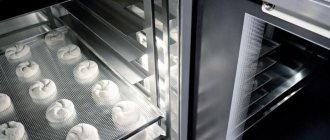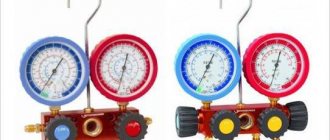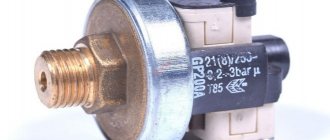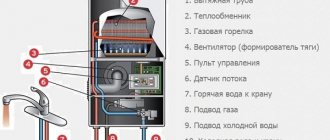A driver who independently maintains a car’s power unit needs to have an understanding of how the thermostat works in a car. The distribution element installed in the engine compartment ensures the distribution of antifreeze flows and maintains the degree of engine heating. When the valve jams, the engine operates in emergency mode, which leads to breakdowns or increased fuel consumption.
Functions in the air conditioning system
The liquid cooling (or air conditioning) system consists of a jacket located in the cylinder block and cylinder head, a pump, a radiator and connecting pipes. Part of the liquid is supplied to a separate heat exchanger for heating the cabin. The intensity of air heating is regulated by a tap (for example, on classic VAZ passenger cars) or by a separate damper in the air duct.
The thermostat is designed to distribute coolant flows between the jacket and the radiator, ensuring the operating temperature of the engine and warming up the interior.
Purpose and design features of the thermostat
The thermostat is designed to block the circulation of fluid through the cooling system until the car engine is completely warmed up in order to speed up this process and further maintain the required operating temperature.
Thermostat operating principle
is based on the melting of artificial wax placed in a small cylinder in the direction of the motor. Wax melts at a temperature of at least 80 degrees. At the same time, it expands, increasing in volume, due to which it squeezes the locking pin out of the cylinder, unlocking the thermostat valve and restoring circulation.
In general, a thermostat consists of:
- inlet pipe connected to the engine cooling system;
- bypass valve, which, if necessary, shuts off the small cooling circle;
- an outlet pipe connected to the coolant pump;
- spring holding the bypass valve;
- wax ball;
- inlet pipe connected to the radiator;
- springs holding the main valve;
- the main valve itself, designed to shut off the main circulation;
- piston;
- housings.
Thermostat device.
Before the engine warms up, the circulation of the coolant does not stop completely - it is carried out in a so-called small circle, where the coolant flows from the pump only through the cooling jacket and the heater radiator, so that the system does not stagnate. When the main circulation valve opens, the small circle is automatically closed.
That is, the entire thermostat device is actually just a cylinder, a return pin, wax and a number of minor parts. This simple thermostat circuit is effective and reliable, so it remains the same in most newer cars.
In different car models, thermostats are set to different opening temperatures, which are most often indicated on the device body. In addition, different cars can be installed with or without housing thermostats. Their main difference is the installation itself, either in the engine block, or in a separate housing, which is a complex two-level circuit.
Types of thermostats
Several types of thermostats are used in car power plants:
- With 2 valves, which provides control of the refrigerant flows going to the radiator and through a small cooling circle (through the power unit jacket and the cabin heating unit).
- With 1 moving element that adjusts the flow of fluid to the radiator.
- With 1 valve and two-stage opening. When the engine warms up, a small diameter duct opens, then antifreeze is supplied to the heat exchanger through an opening with a larger cross-section.
- Electronic thermostat equipped with a sensor that measures the temperature of the antifreeze. The control unit fixes the position of the damper using a stepper motor. The regulator adjusts the supply of antifreeze to additional cooling circuits, which reduces fuel consumption.
Design and principle of operation
After starting the power unit, part of the heat generated during fuel combustion goes to heat the crankcase and the cylinder head. To ensure normal lubrication and improve mixture formation, the engine must warm up to 85-105°C (depending on the internal combustion engine model). The thermostat installed in the cooling circuit does not allow coolant to circulate through the radiator. Antifreeze circulates in the inner circle, allowing the engine to warm up to operating temperature in 5-10 minutes. As the thermostat warms up, it passes refrigerant into the machine's heat exchanger, which is cooled by a fan.
The operating principle of the regulator is based on the thermal expansion of a liquid or solid filler.
The material increasing in volume displaces the rod with the valve, which distributes the flow of antifreeze. The circuit includes springs that return the dampers to their original position when the liquid temperature decreases. The structural elements are fixed in a housing made of silumin or heat-resistant plastic. Some vehicles have thermostats without an outer shell installed in the cylinder block of the power plant.
Solid thermostats
Regulators with a solid working substance are equipped with a sealed chamber filled with synthetic wax (ceresin). The principle of operation is based on the transition of wax from the solid phase to the liquid phase when heated. The solution acts on the elastic cuff and the pusher associated with it. The movable rod is connected to a poppet valve, allowing antifreeze to circulate in a small (or internal) circle or to allow liquid to pass into the heat exchanger for cooling.
To increase sensitivity to changes in the degree of heating, additives based on metal powder are introduced into the wax.
The resulting material is characterized by a stable expansion coefficient during the transition from solid to liquid phase and vice versa. By stabilizing the parameter, the refrigerant temperature is maintained within the acceptable range.
Thermostat with liquid
A regulator with a liquid working substance is designed similarly to a design with a solid filler, but the solution is contained in a sealed bellows. The liquid consists of a mixture of distilled water and ethyl alcohol. With thermal expansion, excess pressure arises in the bellows. The element straightens and, through a rod connected to it, opens a channel for discharging antifreeze into the heat exchanger tank. The amount of liquid pumped into the radiator depends on the temperature of the antifreeze in the cylinder block.
Symptoms of device malfunction
Clear signs of a thermostat malfunction are:
- long warm-up of the engine to operating temperature, as well as rapid overheating;
- the engine temperature arrow drops at speeds below normal and rises when the car stops;
- the lower pipe is warm after a few minutes of warming up the engine: this means that the thermostat is open all the time;
- The thermostat is stuck in the closed position, the engine is boiling, and the lower pipe remains cold even when the engine is warm
Malfunctions: causes and “symptoms”
Signs of regulator malfunction:
- long warm-up of the power unit;
- warming up the outlet hose simultaneously with the motor;
- increase in engine temperature to a critical level during parking;
- hypothermia of the power unit during highway driving;
- cold state of the antifreeze supply pipe to the heat exchanger when overheated.
The cause of regulator failure is the stem sticking with the valve in the open or closed position. When the large circle is open, liquid is supplied to the radiator, increasing the warm-up time. The malfunction becomes apparent when the vehicle is operated in winter. For example, a diesel engine at an air temperature of -10°C cannot be warmed up to 40°C even after a run of 40-50 km.
Rod jamming occurs due to the negative effect of antifreeze on metal structural elements. Car manufacturers recommend periodically replacing the coolant. When using old antifreeze, deposits appear on the surface of the rod, limiting the mobility of the part. An additional cause of the defect is filling the cooling system with tap water (for example, if there is an antifreeze leak). Salts dissolved in the liquid cause corrosion of the steel rod.
Increasing the degree of engine heating negatively affects the performance of the engine oil. When the engine overheats, the piston group jams. Scores appear on the surfaces of the cylinder mirrors and the crankshaft and camshaft supports. Damage can only be repaired during a major overhaul of the engine.
An additional malfunction of the thermostat is cracks in the housing through which antifreeze escapes. Damaged parts must be replaced: it is impossible to solder or seal the cracks.
What is it, the purpose of the device
A car thermostat is the main component of the cooling system. Its purpose is to control temperature indicators with subsequent redistribution of antifreeze or antifreeze throughout a large or small circulation circle. While the engine is warming up, the system's safety valve is in the closed position and the fluid is in a small circle. Because of this, the engine warms up faster.
After reaching the required temperature, to avoid overheating, the safety valve is activated, and the antifreeze passes into a large circle. Coolant is supplied through the radiator, significantly improving engine cooling.
Where is the thermostat installed in a car?
The thermostatic mechanism is small in size, making it invisible among other parts under the hood. But that doesn't make it any less significant. The small system occupies a position between the small and large circle of movement of the cooling component.
In general, you can drive with a non-working car thermostat, but this will affect the performance of the car’s internal combustion engine. It will quickly overheat and wear will increase. You can replace the system unit yourself (in separate machines). If the engine compartment of a particular model is unknown, it is better to trust the professionals, because there are valuable components nearby that can be damaged.
Attention! A car thermostat is a special-purpose device that maintains engine temperature in the required range. This function is achieved with coordinated and fully functional operation of the thermostat and timely phase transition.
Blocking the radiator function ensures that the engine reaches its maximum temperature. This is necessary to fully disclose the characteristics of the power unit. Such conditions help reduce the intensity of its wear.
The main functional element is the valve. It operates at temperatures between 70 and 92 degrees Celsius. The exact indicator is determined after clarifying the specific design and the required operating mode of the car engine.
How to determine if there is a breakdown?
Primary diagnostics of the thermostat is carried out on the car. After starting the engine, check the temperature of the pipes going to the radiator (by hand or with a sensor mounted on a digital multimeter). After warming up the engine, it is necessary to check the degree of heating of the hoses going to the radiator. If the thermostat is working properly, the hoses should heat up evenly. The technique allows you to determine whether the valve stem and disc are jammed. The absence of cracks in the body parts of the regulator is also checked.
Additional testing involves removing the regulator from the machine. Antifreeze is drained from the cooling system; rubber pipes are held on the thermostat housing with screw or spring clamps (depending on the car manufacturer). The dismantled element is needed to be immersed in a container of water, which is installed on a gas or electric stove. To check the degree of heating of the liquid, use a thermometer or electronic thermometer.
When the water warms up to 90°C and above in a working thermostat, the valve should open. The opening process is controlled visually: if the plate remains motionless, the regulator must be replaced with a device with identical performance characteristics. The visual inspection method is not very accurate, since it is impossible to track the relationship between the valve position and the degree of heating. The correct heating of the power unit and maintaining the set temperature depend on this parameter.











